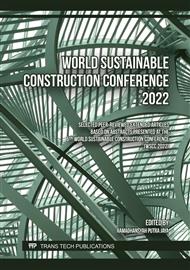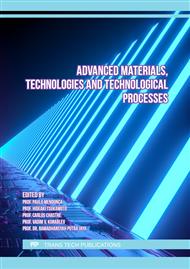[1]
Abidin, İ. S. Z. , Haseeb, M. , Islam, R., Regional Integration of the Association of Southeast Asian Nations Economic Community: An Analysis of Malaysia - Association of Southeast Asian Nations Exports". International Journal of Economics and Financial Issues 6 (2016 ): 646-652
DOI: 10.4337/9781785364495.00016
Google Scholar
[2]
Olanrewaju, A., AbdulAziz, A., Preece, C., & Shobowale, K. (2021). Evaluation of measures to prevent the spread of COVID-19 on the construction sites. Cleaner Engineering And Technology, 5, 100277
DOI: 10.1016/j.clet.2021.100277
Google Scholar
[3]
Ab RAzak, Mohd Yusrizal. 2022. "Department Of Statistics Malaysia Official Portal". Dosm.Gov.My. https://www.dosm.gov.my/.
Google Scholar
[4]
Alaloul, Wesam Salah, Muhammad Ali Musarat, Muhammad Babar Ali Rabbani, Qaiser Iqbal, Ahsen Maqsoom, and Waqas Farooq. 2021. "Construction Sector Contribution to Economic Stability: Malaysian GDP Distribution" Sustainability 13, no. 9: 5012
DOI: 10.3390/su13095012
Google Scholar
[5]
Aprianti S, Evi. 2017. "A Huge Number Of Artificial Waste Material Can Be Supplementary Cementitious Material (SCM) For Concrete Production – A Review Part II". Journal Of Cleaner Production 142: 4178-4194.
DOI: 10.1016/j.jclepro.2015.12.115
Google Scholar
[6]
Kabir, S.M. Alamgir, U. Johnson Alengaram, Mohd Zamin Jumaat, Sumiani Yusoff, Afia Sharmin, and Iftekhair Ibnul Bashar. 2017. "Performance Evaluation And Some Durability Characteristics Of Environmental Friendly Palm Oil Clinker Based Geopolymer Concrete". Journal Of Cleaner Production 161: 477-492.
DOI: 10.1016/j.jclepro.2017.05.002
Google Scholar
[7]
Ibrahim, H. A., & Abdul Razak, H. (2016). Effect of palm oil clinker incorporation on properties of pervious concrete. Construction and Building Materials, 115, 70–77.
DOI: 10.1016/j.conbuildmat.2016.03.181
Google Scholar
[8]
Mohan, Harish T., Karingamanna Jayanarayanan, and K.M. Mini. 2021. "Recent Trends In Utilization Of Plastics Waste Composites As Construction Materials". Construction And Building Materials 271: 121520.
DOI: 10.1016/j.conbuildmat.2020.121520
Google Scholar
[9]
Jannat, N., Latif Al-Mufti, R., Hussien, A., Abdullah, B., & Cotgrave, A. (2021). Utilisation of nutshell wastes in brick, mortar and concrete: A review. Construction And Building Materials, 293, 123546
DOI: 10.1016/j.conbuildmat.2021.123546
Google Scholar
[10]
Ramesh, R., Alengaram, U. J., Zamin, M., Binti, S., & Ganasan, R. (2019). Performance evaluation of masonry grout containing high volume of palm oil industry by-products. Journal of Cleaner Production, 220, 1202–1214
DOI: 10.1016/j.jclepro.2019.02.134
Google Scholar
[11]
Zhang, L. (2013). Production of bricks from waste materials – A review. Construction And Building Materials, 47, 643-655
DOI: 10.1016/j.conbuildmat.2013.05.043
Google Scholar
[12]
Abutaha, F., & Razak, H. A. (2017). Effect of Coating Palm Oil Clinker Aggregate on the Engineering Properties of Normal Grade Concrete
DOI: 10.3390/coatings7100175
Google Scholar
[13]
Darvish, P., Alengaram, U. J., Poh, Y. S., Ibrahim, S., & Yusoff, S. (2020). Volume based design approach for sustainable palm oil clinker as whole replacement for conventional sand in mortar. Journal of Building Engineering, 32, 101660
DOI: 10.1016/j.jobe.2020.101660
Google Scholar
[14]
Nalon, G., Santos, R., Lima, G., Andrade, I., Pedroti, L., Ribeiro, J., & Franco de Carvalho, J. (2022). Recycling waste materials to produce self-sensing concretes for smart and sustainable structures: A review. Construction And Building Materials, 325, 126658.
DOI: 10.1016/j.conbuildmat.2022.126658
Google Scholar
[15]
Kulkarni, P., Ravekar, V., Rama Rao, P., Waigokar, S., & Hingankar, S. (2022). Recycling of waste HDPE and PP plastic in preparation of plastic brick and its mechanical properties. Cleaner Materials, 5, 100113
DOI: 10.1016/j.clema.2022.100113
Google Scholar
[16]
ASTM C55 (2017). Standard specification for concrete building brick. ASTM Internationals, West Conshohocken, Philadelphia.
Google Scholar
[17]
Muthusamy, K., Budiea, A. M., Syed Mohsin, S. M., Muhammad Zam, N. S., & Ahmad Nadzri, N. E. (2021). Properties of fly ash cement brick containing palm oil clinker as fine aggregate replacement. Materials Today: Proceedings, 46, 1652–1656
DOI: 10.1016/j.matpr.2020.07.260
Google Scholar
[18]
Asadi, I., Shafigh, P., Hashemi, M., Akhiani, A., Maghfouri, M., & Sajadi, B. et al. (2021). Thermophysical properties of sustainable cement mortar containing oil palm boiler clinker (OPBC) as a fine aggregate. Construction And Building Materials, 268, 121091
DOI: 10.1016/j.conbuildmat.2020.121091
Google Scholar
[19]
Angelin, A. F., Lintz, R. C. C., Gachet-Barbosa, L. A., & Osório, W. R. (2017). The effects of porosity on mechanical behavior and water absorption of an environmentally friendly cement mortar with recycled rubber. Construction and Building Materials, 151, 534–545
DOI: 10.1016/j.conbuildmat.2017.06.061
Google Scholar



